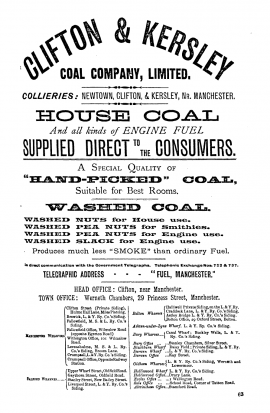
The Clifton & Kersley Coal Company, or Clifton & Kearsley Coal Company, operated in Clifton and Kearsley on the south side of the Irwell Valley on the Lancashire CoalfieldThe Lancashire and Cheshire Coalfield in North West England was one of the most important British coalfields. Its coal seams were formed from the vegetation of tropical swampy forests in the Carboniferous period more than 300 million years ago.. Its collieries exploited the coal seams of the Middle Coal Measures of the Manchester CoalfieldPart of the Lancashire Coalfield. Some easily accessible seams were worked on a small scale from the Middle Ages, and extensively from the beginning of the Industrial Revolution until the last quarter of the 20th century.. John Heathcote sank pits in the 1730s, and in the 1740s he employed Matthew Fletcher, whose family had extensive interests in coal mining in the area. By the 1750s Fletcher owned the collieries.[1]
The company owned the Newtown and Wet Earth Collieries in Clifton, Outwood Colliery in Outwood and Little Hey, Manor, Scowcrofts and Spindle Point Collieries in Kearsley. The Pilkington Colliery Company, started by Edward and Alfred Pilkington in 1867,[2] bought the company in 1885. When coal reserves became depleted in the Irwell Valley the company started to sink a new pit to 890 yards (814 m) on the north side of the Bridgewater Canal in Astley in 1908 and Astley Green Colliery opened in 1912.[3]
In 1896 the company employed 2,729 workers, 2,146 underground and in 1923 it employed 4,300 workers, nearly 2,000 of them at its newest colliery, Astley Green. In 1929 the company’s Astley Green, Outwood and Newtown Collieries became part of Manchester CollieriesCoal mining company with headquarters in Walkden, Lancashire, formed in 1929 by the merger of a group of independent companies operating on the Manchester Coalfield. .[4]
